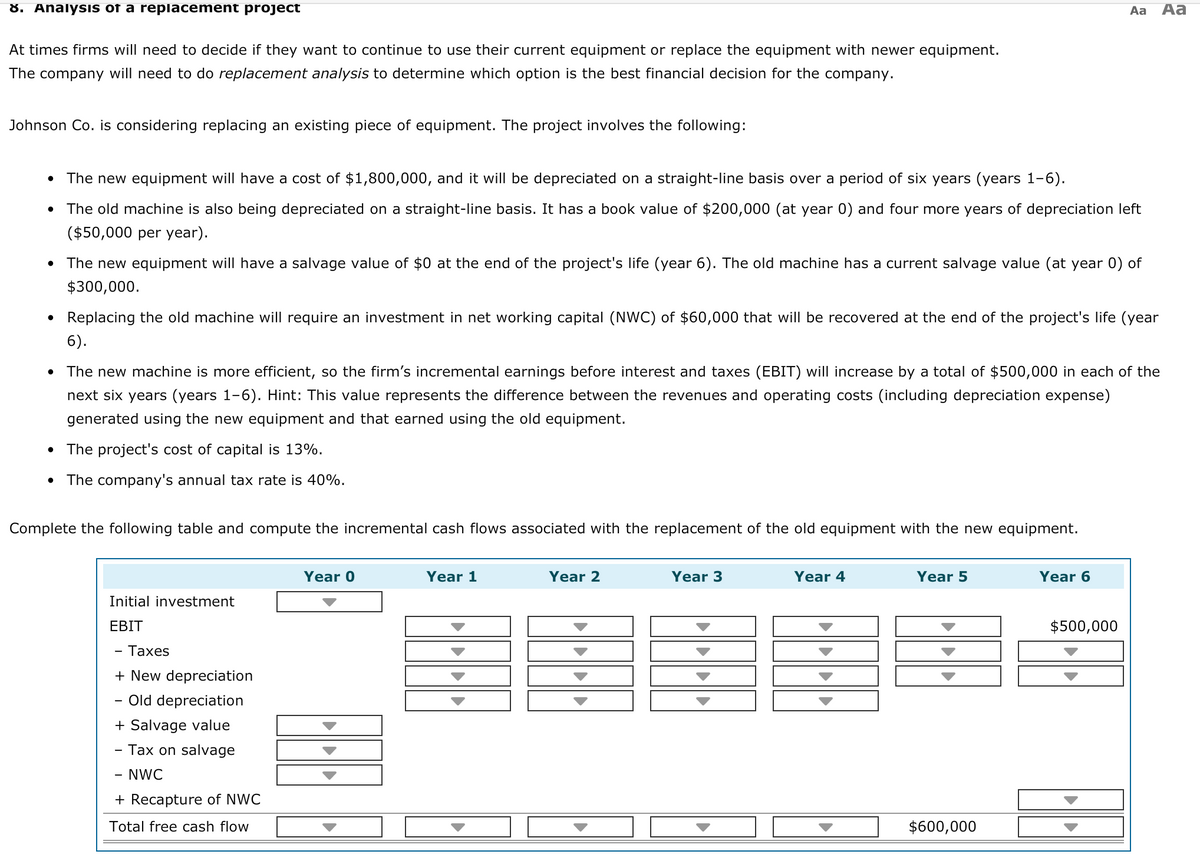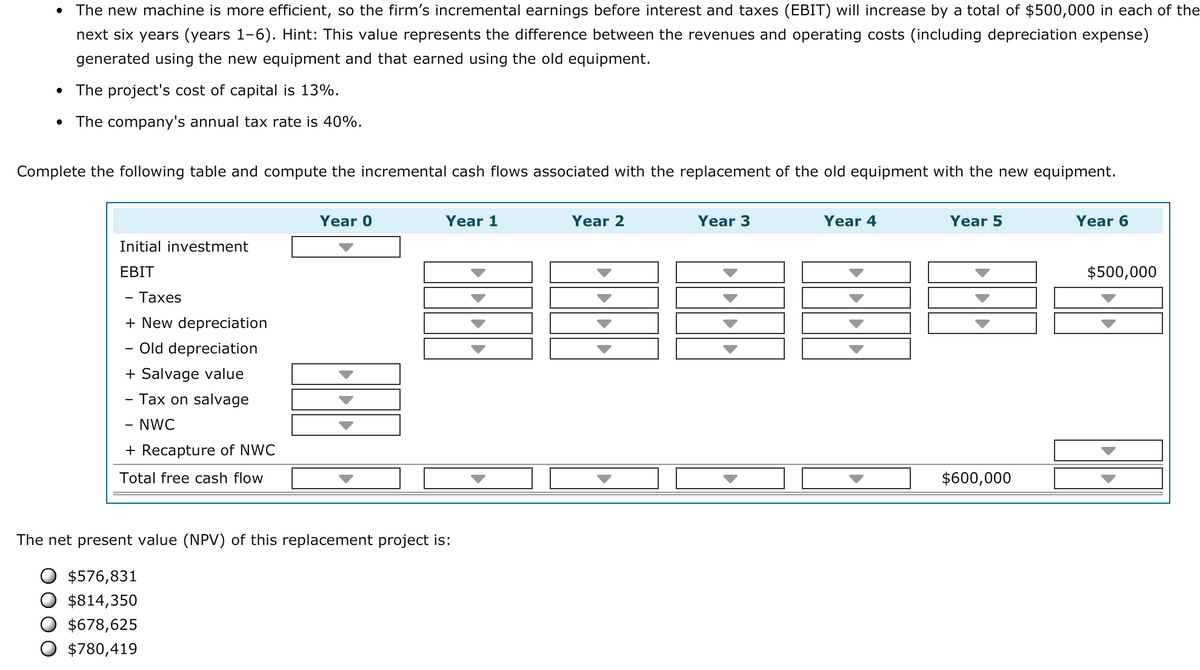At times firms will need to decide if they want to continue to use their current equipment or replace the equipment with newer equipment. The company will need to do replacement analysis to determine which option is the best financial decision for the company. Johnson Co. is considering replacing an existing piece of equipment. The project involves the following: • The new equipment will have a cost of $1,800,000, and it will be depreciated on a straight-line basis over a period of six years (years 1-6). The old machine is also being depreciated on a straight-line basis. It has a book value of $200,000 (at year 0) and four more years of depreciation left ($50,000 per year). • The new equipment will have a salvage value of $0 at the end of the project's life (year 6). The old machine has a current salvage value (at year 0) of $300,000. • Replacing the old machine will require an investment in net working capital (NWC) of $60,000 that will be recovered at the end of the project's life (year 6). • The new machine is more efficient, so the firm's incremental earnings before interest and taxes (EBIT) will increase by a total of $500,000 in each of the next six years (years 1-6). Hint: This value represents the difference between the revenues and operating costs (including depreciation expense) generated using the new equipment and that earned using the old equipment. • The project's cost of capital is 13%. The company's annual tax rate is 40%.
At times firms will need to decide if they want to continue to use their current equipment or replace the equipment with newer equipment. The company will need to do replacement analysis to determine which option is the best financial decision for the company. Johnson Co. is considering replacing an existing piece of equipment. The project involves the following: • The new equipment will have a cost of $1,800,000, and it will be depreciated on a straight-line basis over a period of six years (years 1-6). The old machine is also being depreciated on a straight-line basis. It has a book value of $200,000 (at year 0) and four more years of depreciation left ($50,000 per year). • The new equipment will have a salvage value of $0 at the end of the project's life (year 6). The old machine has a current salvage value (at year 0) of $300,000. • Replacing the old machine will require an investment in net working capital (NWC) of $60,000 that will be recovered at the end of the project's life (year 6). • The new machine is more efficient, so the firm's incremental earnings before interest and taxes (EBIT) will increase by a total of $500,000 in each of the next six years (years 1-6). Hint: This value represents the difference between the revenues and operating costs (including depreciation expense) generated using the new equipment and that earned using the old equipment. • The project's cost of capital is 13%. The company's annual tax rate is 40%.
Financial Management: Theory & Practice
16th Edition
ISBN:9781337909730
Author:Brigham
Publisher:Brigham
Chapter11: Cash Flow Estimation And Risk Analysis
Section: Chapter Questions
Problem 4P: Although the Chen Company’s milling machine is old, it is still in relatively good working order and...
Related questions
Question
100%

Transcribed Image Text:8. Analysis of a replacement project
Aa
Aa
At times firms will need to decide if they want to continue to use their current equipment or replace the equipment with newer equipment.
The company will need to do replacement analysis to determine which option is the best financial decision for the company.
Johnson Co. is considering replacing an existing piece of equipment. The project involves the following:
The new equipment will have a cost of $1,800,000, and it will be depreciated on a straight-line basis over a period of six years (years 1-6).
• The old machine is also being depreciated on a straight-line basis. It has a book value of $200,000 (at year 0) and four more years of depreciation left
($50,000 per year).
The new equipment will have a salvage value of $0 at the end of the project's life (year 6). The old machine has a current salvage value (at year 0) of
$300,000.
Replacing the old machine will require an investment in net working capital (NWC) of $60,000 that will be recovered at the end of the project's life (year
6).
• The new machine is more efficient, so the firm's incremental earnings before interest and taxes (EBIT) will increase by a total of $500,000 in each of the
next six years (years 1-6). Hint: This value represents the difference between the revenues and operating costs (including depreciation expense)
generated using the new equipment and that earned using the old equipment.
The project's cost of capital is 13%.
• The company's annual tax rate is 40%.
Complete the following table and compute the incremental cash flows associated with the replacement of the old equipment with the new equipment.
Year 0
Year 1
Year 2
Year 3
Year 4
Year 5
Year 6
Initial investment
EBIT
$500,000
- Taxes
+ New depreciation
Old depreciation
+ Salvage value
Tax on salvage
- NWC
+ Recapture of NWC
Total free cash flow
$600,000

Transcribed Image Text:The new machine is more efficient, so the firm's incremental earnings before interest and taxes (EBIT) will increase by a total of $500,000 in each of the
next six years (years 1-6). Hint: This value represents the difference between the revenues and operating costs (including depreciation expense)
generated using the new equipment and that earned using the old equipment.
The project's cost of capital is 13%.
The company's annual tax rate is 40%.
Complete the following table and compute the incremental cash flows associated with the replacement of the old equipment with the new equipment.
Year 0
Year 1
Year 2
Year 3
Year 4
Year 5
Year 6
Initial investment
EBIT
$500,000
- Тахes
+ New depreciation
Old depreciation
+ Salvage value
- Tax on salvage
-
- NWC
+ Recapture of NWC
Total free cash flow
$600,000
The net present value (NPV) of this replacement project is:
$576,831
$814,350
$678,625
$780,419
Expert Solution
This question has been solved!
Explore an expertly crafted, step-by-step solution for a thorough understanding of key concepts.
This is a popular solution!
Trending now
This is a popular solution!
Step by step
Solved in 2 steps with 2 images

Knowledge Booster
Learn more about
Need a deep-dive on the concept behind this application? Look no further. Learn more about this topic, finance and related others by exploring similar questions and additional content below.Recommended textbooks for you


Intermediate Financial Management (MindTap Course…
Finance
ISBN:
9781337395083
Author:
Eugene F. Brigham, Phillip R. Daves
Publisher:
Cengage Learning

Fundamentals Of Financial Management, Concise Edi…
Finance
ISBN:
9781337902571
Author:
Eugene F. Brigham, Joel F. Houston
Publisher:
Cengage Learning


Intermediate Financial Management (MindTap Course…
Finance
ISBN:
9781337395083
Author:
Eugene F. Brigham, Phillip R. Daves
Publisher:
Cengage Learning

Fundamentals Of Financial Management, Concise Edi…
Finance
ISBN:
9781337902571
Author:
Eugene F. Brigham, Joel F. Houston
Publisher:
Cengage Learning

EBK CONTEMPORARY FINANCIAL MANAGEMENT
Finance
ISBN:
9781337514835
Author:
MOYER
Publisher:
CENGAGE LEARNING - CONSIGNMENT

Cornerstones of Cost Management (Cornerstones Ser…
Accounting
ISBN:
9781305970663
Author:
Don R. Hansen, Maryanne M. Mowen
Publisher:
Cengage Learning

Managerial Accounting: The Cornerstone of Busines…
Accounting
ISBN:
9781337115773
Author:
Maryanne M. Mowen, Don R. Hansen, Dan L. Heitger
Publisher:
Cengage Learning